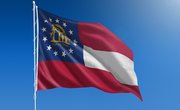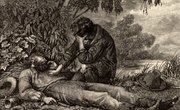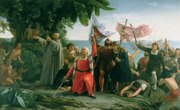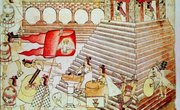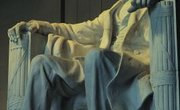For any student who has ever studied United States history, the arrival of the pilgrims at Plymouth Rock in November 1620 is the event that signals the beginning of the European conquest of North America, known to colonists as the "New World." The band of settlers left England and the Netherlands in hopes of finding a land less lascivious and more pious, where they could build their perfect utopian society. This expedition would be the first step toward the creation of the United States.
Tip
The pilgrims landed at Plymouth Rock in November 1620.
When Did the Mayflower Arrive in Plymouth?
The history of the ship the Mayflower prior to 1607 is unknown, but in 1607, the ship was purchased by a man named Christopher Jones and a group of additional business partners. Jones was hired to sail on trade routes around Europe and in 1620 was hired to bring the pilgrims to the northern part of the Virginia colonies.
The pilgrims had initially intended to settle in the northern part of the Virginia colonies, which would be present-day New York City. They had heard reports that the Hudson Valley was an optimal place to build a settlement and planned to land in the Hudson River and begin building their city there. However, they ran into difficulty that changed the course of their journey and the course of American history.
On November 9, the pilgrims spotted what would eventually be Cape Cod. Rather than stopping there, they attempted to push ahead down the coastline toward New York, but a terrible storm beat them back, and they ultimately chose to make the landing in the cape. After sailing around the area for a while, the colonists elected the Plymouth area as the place to begin building the new city. They retreated in an attempt to avoid shipwreck, rounded the cape and ultimately docked the boat at what is known today as Provincetown Harbor.
For the next month and a half, the settlers explored the region in an attempt to find a place to build their camp. They settled on Plymouth Colony on December 25 and began the preparations to construct their first buildings and shelter in response to the harsh winter environment. Initially, only the most able-bodied of the passengers disembarked the Mayflower to begin an exploration of the region. After several weeks of looking, they discovered what they believed to be an encampment that had been abandoned by the Wampanoag tribe. There was fresh water, access to the harbor, cleared fields and other preparations that made it a good place to set up camp.
The History of the Pilgrims' Landing
Despite there being virtually no historical documentation to prove it, American historical lore states that the Pilgrims' first steps on American soil were taken at Plymouth Rock. This has been roundly disputed, particularly since evidence has proven that the pilgrims made their first landfall on the tip of Cape Cod before electing to sail forth toward Plymouth. Nevertheless, the myth has persisted, and the site of Plymouth Rock has been accepted as the first place where settlers stepped in what would become the United States.
When the pilgrims finally began to build structures in the Plymouth Colony, they were hampered significantly by the hard winter weather, the rawness of the terrain and the constant threat of fire that regularly destroyed their structures. Following the pilgrims' landing, each family in the Plymouth Colony was responsible for constructing their own house on land that was apportioned to them. In addition, all citizens of the colony were required to supply the needed labor to create community buildings, storehouses, sheds, forts and defensive structures.
The land there was apportioned to pilgrims based on the size of their families. The larger the family, the larger the tract of land given to them on which to build. Despite the abundance of space in the region for building, farming and keeping livestock, the weather in the Plymouth colony during the winter of 1620 was harsh and terrible enough that the majority of pilgrim families chose to remain living onboard the Mayflower throughout the winter.
Who Was on the Mayflower Passenger List?
According to the reports of various historians, there were around 102 passengers aboard the Mayflower when it arrived in the New World. The passengers were mostly separatists who were eager to break with the Church of England, which they believed had fallen into corruption. These families, accompanied by other nonseparatist families and their servants, elected to make the journey to the New World.
These citizens hired Jones and his ship the Mayflower to make the journey. Initially, the Mayflower was meant to sail at the same time as another ship, the Speedwell, which had come from the Netherlands. However, due to numerous issues with the Speedwell leaking and showing signs of damage and disrepair, it was believed that the ship would not survive the voyage from England to the colony of Virginia. Those passengers who initially planned to sail on the Speedwell instead joined those on the Mayflower.
There was a lot of concern about the strain that a long sea journey and the effort of homesteading in an inhospitable climate might put on the bodies of women, who were perceived as being frailer, weaker and more likely to fall ill or be injured. Ultimately, when the Mayflower set sail, there were 18 adult women onboard, three of whom were pregnant. One passenger, William Butten, died during the course of the Mayflower's voyage. However, the birth of another passenger, Oceanus Hopkins, allowed the number onboard the ship to remain at 102. Approximately half of the passengers were religious separatists who were leaving England or the Netherlands for reasons of religious freedom. The other half were nonseparatists who were traveling to the New World for other reasons along with their servants or staff. There were also around five crewmen onboard the boat who are counted in that number.
Most of the pilgrims aboard the Mayflower had come from a tiny village in Holland called Leiden. These citizens had left religious persecution in England. Though they were more free to practice their radical version of Christianity in the Netherlands than they had been in England, life was still not easy. Out of fears of losing their English heritage and worries about a possible war between Spain and the Netherlands, the separatists decided to make the journey to America, where they could establish a colony that reflected their extremely religious values and live without fear of persecution or the loss of their history and culture.
Initially, the idea that the pilgrims had was that their entire congregation would set up a colony in the northern part of the Virginia territory, which was significantly larger than the state of Virginia is today and included what are now parts of New York and New Jersey. To finance their journey and the cost of setting up a civilization in the New World, the pilgrims made a contract with investors who supplied them with necessary funds. In exchange, the pilgrims agreed to send resources from the New World such as lumber, fish and furs back to England.
How the Mayflower Voyage Changed America
The arrival of the pilgrims on the Mayflower set into motion the events that would cement the 13 colonies as a growing community and would create the conditions for the colonies to eventually fight for their own independence. Although there had been several attempts at colonizing other parts of the New World, in 1620 the population of North America was almost exclusively made up of native people. The arrival of European immigrants, or "colonists," would set into motion a chain of events that saw the near total annihilation of the native people and an eventual full takeover of the country by the descendants of the colonists.
Most of the colonists arriving in the New World were there because they wanted to pursue religious freedom and felt that the Church of England had fallen into corruption. In an effort to distance themselves from the church, they endeavored to start a new religious life on this new continent. The separatists who colonized in Plymouth were known as "Puritans." They were extremely religious, and their practices were austere.
The Pilgrims' Relationship With Native People
Despite a proliferation of native people in the area, it took months before the pilgrims made any contact with the native population in Cape Cod. The Plymouth Colony was situated close to the habitat of a tribe of native people known as the Wampanoag. There was much worry on the part of both the native people and the settlers that there would be violence, stealing and other difficulties that posed a significant fear, especially to the settlers, who were in an unfamiliar territory without an understanding of the land or the ways in which they might survive.
In March 1621, the pilgrims made a protective pact with the leader of the Wampanoag tribe. They agreed to refrain from harming one another, from bringing weapons when meeting and from stealing from one another. The native people in turn helped the settlers to cultivate crops and land, and their first harvest in 1621 was celebrated with three days of feasting, entertainment and merriment. This was the basis for the celebration that would later become the Thanksgiving holiday.
Why Were They Called Pilgrims?
The word "pilgrim" is generally taken to mean a person who travels on a long journey, often to a foreign land for religious or moral purposes. Pilgrims taking pilgrimages to religious sites of importance or leaving their home to travel to a new place where they would be free to worship and live in accordance with the laws of their religion is a phenomenon in every religion throughout history.
The term's association with Christianity and American history, however, is related to the pilgrims who traveled to the New World in search of freedom from religious persecution. During the early 1800s, the term "pilgrim" was applied to everyone who had come to the New World aboard the Mayflower and even to those arriving in the Plymouth Colony afterward. In the years following and even today in discussions about that period, the term "pilgrim" is broadly applied to any English settler who came to the Massachusetts Bay Colony in the 1620s in hopes of beginning a new life.
How Many Pilgrims Survived the First Winter in Plymouth?
Although only one person died on the Mayflower's voyage from England to what would become Plymouth, Massachusetts, the first winter in the New World proved to be far deadlier. The pilgrims had a number of illnesses following the long sea voyage, including scurvy, pneumonia and other conditions stemming from poor nutrition, poor shelter, inhospitable climate conditions and stress. It is reported that as many as two or three people died each day after making landfall. Only 52 of the original 102 passengers survived their first year in Plymouth.
Related Articles
References
Writer Bio
Ashley Friedman is a freelance writer with experience writing about education for a variety of organizations and educational institutions as well as online media sites. She has written for Pearson Education, The University of Miami, The New York City Teaching Fellows, New Visions for Public Schools, and a number of independent secondary schools. She lives in Los Angeles.



